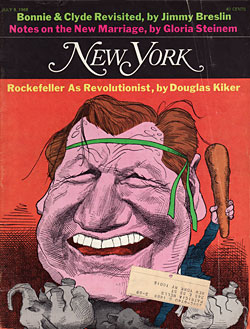 |
From the July 8, 1968 issue of New York Magazine.
I did not like it the first time I saw it. The movie Bonnie and Clyde was the biggest thing in the country when my friend Fat Thomas and I went to see it some months ago. We went early on a Saturday night, at six o'clock, so the place would be empty and we could put our feet up and smoke cigars, but we still didn't like the thing.
Right at the start, Warren Beatty, who plays Clyde Barrow, was standing on the streetcorner and he pulled out a pistol and showed it to Faye Dunaway, who plays Bonnie Parker. She began to run her hand on the black barrel of the pistol. Run her hand on it lovingly.
"That's a lot more than a pistol right now," I said.
"She gets one of them jammed into her back, she don't go around petting it, I guarantee her that," Fat Thomas said.
We began to discuss which was sicker, the airedale dog they put into a love scene in Here We Go Round the Mulberry Bush or the broad gently petting the gun in Bonnie and Clyde. When Fat Thomas and I saw the airedale dog in Mulberry Bush, we were in a private screening room and both of us began yelling out, "Look out for the hoof and mouth disease." The people who put either of these scenes, the gun or the dog, on the screen should have their hands held over the kitchen stove, but if you have to choose between the two, it is no contest. The thing with the girl petting the gun is a much sicker proposition.
After the gun scene, the movie progressed in similar fashion. The photography was striking. The light usages ran from haze to flat to crystal-like and it was wonderful to watch. But there always was this studied, playing-with-yourself handling of guns. Now when we were kids, the big movie, the biggest maybe, was Kiss Tomorrow Goodbye with Jimmy Cagney. The great scene in the movie, the one we all clapped for, came when Cagney had a rat stool pigeon locked in the trunk of his car and the stool pigeon's muffled voice said he wanted air and Cagney grinned and said, well, we'll give you air, you rat stool pigeon, and he took out a gun that was bigger than he was and put six shots into the trunk. It was Cagney's face and style of body movement which captured everybody. You never noticed the gun. Cagney played a tough guy so intensely that he was comical. But here in Bonnie and Clyde, it was different. The gunfire was more important than the faces, and everything was cloaked in beauty. At the end of the movie there was this very pretty machine-gunning of the two stars. Pretty people in pretty sunlight and neat holes in them and a pretty white dress billowing and Clyde rolling around in clean, pretty grass.
Both of us sitting in the movie had the same reaction. "What the hell do they call this?" we said out loud.
Well, of course, we walked out of the movie and into a splash of Bonnie and Clyde promotion. The picture was doing knockout business, the reviews were out of sight, there was a song about it on every juke box, the department stores were featuring Bonnie and Clyde fashions and at a cocktail party with all smart people, somebody brought up the picture and everybody said, oh, was that great, and I murmured something about why I didn't like it and a real smart woman turned on me.
"You didn't really see it," she told me. "The idea was to provide a revulsion at violence. That was what the over-kill at the end was for. It signified revulsion at violence, don't you understand?"
Of course, I went back on myself. I don't go to many movies and I figured I wasn't up with what they are doing on the screen, so I was showing some basic strain of illiteracy by not liking the movie. I looked down at my drink and said, well, I guess you're right, and I let the thing go at that. I did the same thing the guy from Newsweek, Joe Morgenstern, did. He wrote a review knocking the movie and he heard so much criticism of the review that he went back and did another one, and the second time he said the picture was great.
In all the months that the picture was around big, I only heard of one person who was against the picture so much that he wouldn't even go and see it.